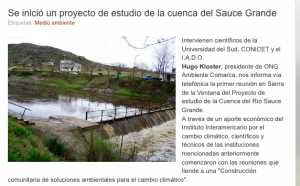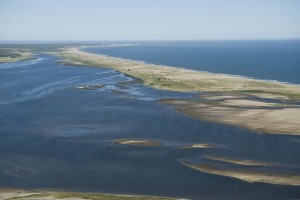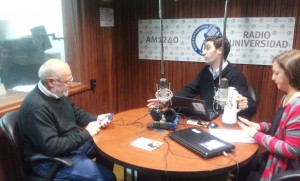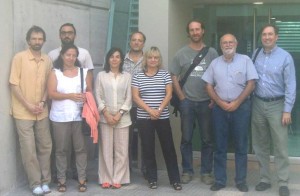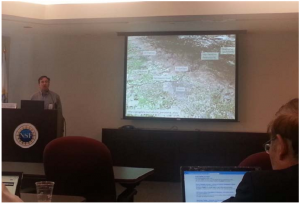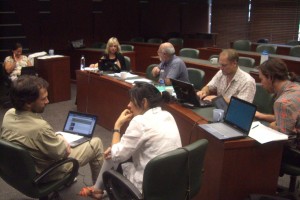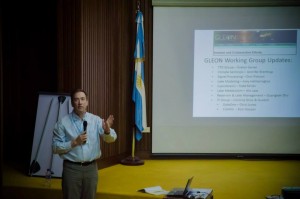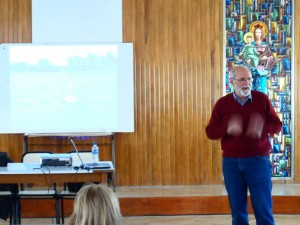SAFER: Sensing the Americas’ freshwater ecosystem risk from climate change (CRN 3038)

Project information
Instituto Argentino de Oceanografía (CONICET-UNS), Argentina
CONICET (Argentina):
Project brief: The state of American lakes and lagoons
Results Outreach investigators Students Executive summary Photos
Results
This is a summary of the most salient project results. For further information see the project website, project papers or contact the investigators directly.
This network studies shallow lakes as sentinels of environmental change. Diel changes in dissolved oxygen revealed net autotrophic conditions, temperature, light, water level and conductivity are the main regulators of the ecosystem and are influenced by water management.
Interviews showed that social perceptions on the value of ecosystem services and on risk can contribute to realistic adaptation to climate effects, and that public policies could be improved by recognizing the value of healthy functioning ecosystems. Climate change aggravates chronic social vulnerabilities since social groups are affected by both the change and by risk management actions. Understanding the different perceptions, responses and adaptation modes to climate hazards supports policies that lessen iniquities and vulnerability.
Shallow lake areal variation measured on MODIS images, and land use intensity based on agricultural estimations, were related to the Standard Precipitation Evaporation Index (SPEI), the Oceanic Niño Index (ONI) and in situ annual precipitation data for wet, dry and normal years. Frequency of lake area maxima was more dependent on rainfall regime (ENSO) than on area under cultivation. El Niño (2002/3) and La Niña (2007/8) affected the precipitations of the entire region, with maximum lake areas in 2002 and minima in 2008. The results help planning to mitigate floods and droughts.
Multiproxy 20-year-resolution analysis of forest and lakes in Panama showed a system transition near 1400 CE, from high seasonality probably caused by high El Niño frequency to slower responses under which forest and lake decoupled and responded to global temperatures and local human occupation. These past responses indicate that future higher temperatures, an invigoration of ENSO, and human influence may simplify mid elevation forests with devastating effects for biodiversity.
A screening-level risk analysis (SRA) was developed for risk to Ecosystem Services, using an anthropic pressure factor based on a nation’s Inequality-adjusted Human Development Index (IHDI) and the regulatory Environmental Performance Index (EPI); together with the current Baseline Water Stress (BWS) in a watershed. Future anthropic conditions were derived from a nation’s 10-year trend in IHDI and EPI. The method’s outcomes for 6 sites with a wide range of socio-environmental conditions illustrate that risk may be affected more by climatic pressure in a highly developed region, while in less well-developed regions, human factors are more important. The SRA is easier than more detailed assessments for comparisons among watersheds and regions, so that mitigation efforts can be prioritized.
A first time analysis of 1985-2009 in situ and satellite-derived lake temperatures showed an increase in global mean summer surface water temperatures of 0.34 °C per decade. Warming rates depended on climate and local characteristics. Regional consistency in lake warming was rare. The most rapidly warming lakes are geographically distributed, and affected by interactions between climatic factors: seasonally ice covered lakes where temperature and solar radiation are increasing and cloud cover is diminishing (0.72 °C per decade); or tropical lakes under increasing air temperature and solar radiation (0.53 °C per decade). Such climate impacts and vulnerabilities need to be considered in adaptation efforts for lakes.
A survey on uses of the high-frequency lake data at 46 GLEON sites found that at 69% GLEON buoy data were used beyond academics, for 1) engaging with citizens, 2) educating students and teachers, 3) aiding in decision making. GLEON’s network enables the diffusion of ideas and tools for effective outreach and encourages engagement of scientists in lake protection, restoration, and management.
Lake warming response depends on water residence time, timing and nature of inputs, and local land use. The Southern Andes (42° S) permit large scale testing across one of the strongest bioclimatic gradients in the world: over 2500 mm/y precipitation from Pacific westerlies and orography in coastal temperate rainforest, to 160 mm/y in the cold steppe of Argentina. Lakes vary from dystrophic pacific coastal, to (ultra)oligotrophic Cordilleran, to eutrophic endorrheic basins in the cold steppe.
To use these lakes as sentinels across gradients of physical and social drivers, 5 approaches were combined: (1) in situ monitoring of climatic forcing and lake response using buoys; (2) remote sensing (MODIS, SPOT, Landsat etc.) to scale across the range of lake systems; (3) paleoecological reconstruction; (4) modeling responses of lake ecosystem services; (5) Community Participatory Research. Community engagement provided the first steps to establish a Sister Lake program between the Lake Sunapee Protection Association (LSPA, New Hampshire, USA) and the Sociedad de Fomento de la Laguna La Salada (Pedro Luro, Argentina).
Outreach
Interview with Facundo Scordo, researcher of the SAFER project, Aquí el planeta, ECO Medios, February 2017, effects of on human activities on lakes in the province of Chubut, Argentina.
Interview with PI Gerardo Perillo, local radio station, Bahía Blanca, Argentina (LU2) (in Spanish)
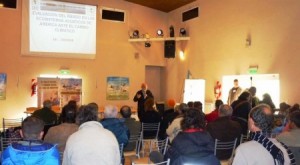 First workshop on climate change and its impact over Sauce Grande river water resources (in Spanish)
First workshop on climate change and its impact over Sauce Grande river water resources (in Spanish)
6 June 2014
The workshop was attended by citizens and intermediate organizations.
TVC Noticias
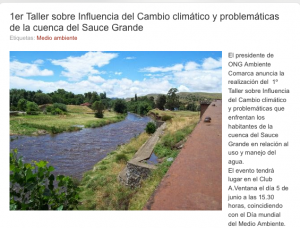 1st workshop on climate change impacts and problems of the Sauce Grande river basin
1st workshop on climate change impacts and problems of the Sauce Grande river basin
Radio interview in Spanish, FM Reflejos, 28 May 2014
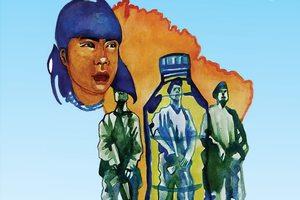 Water thieves (click here to see more about the novel)
Water thieves (click here to see more about the novel)
In the year 2017, a mutant strain of bacteria, capable of surviving the full range of the seasons –including the harshest winters and fearful storms–, has polluted the fresh water of all South America, creating chaos and poverty.Twenty years later, two sisters are forced to survive by stealing water, looking forward to a moment when they can make their escape to the countries in the North. One night, as the sisters infiltrate a house to steal its stash of fresh water, they find themselves involved in an unplanned adventure into the past, fighting to stop the pollution that caused their parents deaths. Water Thieves is the first young adult novel written by Vanesa L. Perillo.
Climate and anthropic effects on lakes in the Senguer River Basin: towards solutions agreed with stakeholders and decision-makers
La variabilidad climática y la presión humana producen alteración del flujo basal, magnitud y momento de las inundaciones, procesos convectivos y otros cambios hidro-meteorológicos en ríos, lagos y embalses, impactando los ecosistemas (eutrofización, contaminación, acidificación, especies invasoras, sobreexplotación, destrucción de hábitat, etc.) y en los servicios que éstos prestan a la comunidad. El proyecto analiza estos procesos y los riesgos sobre los servicios ecosistémicos (SE) asociados en un grupo de cuatro lagos en la cuenca del río Senguer (Chubut), que están correlacionados con un grupo de 5 lagos ubicados en la misma latitud sobre territorio chileno. Esto constituye la primera transecta transcontinental de monitoreo de lagos a nivel mundial.
Project investigators
James Rusak (jim.rusak@ontario.ca)
Queen’s University and the Ontario Ministry of the Environment, Canada
María Isabel Velez Caicedo (maria.velez.caicedo@uregina.ca)
University of Regina, Canada
Brian Reid (brian.reid@ciep.cl)
Universidad Austral de Chile, Chile
Jaime Humberto Escobar Jaramillo (jhescobar@uninorte.edu.co)
Universidad del Norte, Colombia
Daniel Conde (vladddcc@gmail.com)
Universidad de la República, Uruguay
Thomas Harmon (tharmon@ucmerced.edu)
University of California, USA
Students
Alexis Rodriguez, Undergraduate, Universidad de la República, Uruguay.
Alvaro Oñat, Master, Universidad de Concepción, Chile.
Ana Clara Longo, PhD, Universidad Nacoinal de Cuyo, Argentina
Andrea Soledad Brendel, PhD, CONICET, Argentina.
Belén Alfonso, PhD, IADO-CONICET, Argentina.
Bertoni María Belén, Doctorate, Universidad de Buenos Aires, Argentina.
Camila Nerea Carrascal, Undergraduate, Universidad Nacional del Sur, Argentina.
Carina Seitz Rotte, PhD, IADO-CONICET, Argentina.
Carla Alejandra Baleani, Undergraduate, Universidad Nacional del Sur, Argentina.
Carolina Lescano, Undergraduate, Universidad de la República, Uruguay.
Elena Rodó, Master, Universidad de la República, Uruguay.
Enrique Carrasco, Undergraduate, Universidad de Concepción, Chile.
Esteban Flores, Master, Universidad de Concepción, Chile.
Facundo Scordo, PhD, IADO-CONICET, Argentina.
Federico Ferrelli, PhD, Universidad Nacional del Sur, Argentina.
Federico Pérez, Undergraduate, Universidad de la República, Uruguay.
Federico Quintans, PhD, Universidad de la República, Uruguay.
Féliz Ignacio Contreras, PhD, Universidad Nacional del Nordeste, Argentina.
Francisco Fagiani, Undergraduate, Universidad Nacional del Sur, Argentina.
Henry Pai, PhD, University of California, USA.
Josefina Zunino, PhD, IADO-CONICET, Argentina.
Laura Marrero, Master, Universidad de la República, Uruguay.
Manuel Tolza, Undergraduate, Universidad Nacional del Sur, Argentina.
María Belén Bertoni, PhD, Universidad de Buenos Aires, Argentina.
María Florencia Zabaloy, PhD, Universidad Nacional del Sur, Argentina.
Maria Maria Ibañez, Doctorate, Universidad Nacional del Sur, Argentina.
Mariana Nin, Master, Universidad de la República, Uruguay.
Mariana Ruibal , Master, Universidad de la República, Uruguay.
Martina Diaz, Other, Universidad de la República, Uruguay.
Matías Nicolás Schernenco, Undergraduate, Universidad Nacional del Sur, Argentina.
Michael Lavender, PhD, Queen’s University, Canada.
Natalia Elisabet Rios, Undergraduate, Universidad Nacional del Sur, Argentina.
Obinna Ugorji, Master, Univertsity of Regina, Nigeria.
Roxanna Ayllon, PhD, Universidad Austral de Chile, Peru.
Sandra Vilamizar Amaya, PhD, University of California, Colombia.
Silvio Ospino, Other, Universidad del Norte, Colombia.
Valeria Vitale, Undergraduate, Universidad Nacional del Sur, Argentina.
Vanesa Perillo , PhD, University of Vermont, Argentina.
Vanina Aliaga, PhD, IADO-CONICET, Argentina.
Viviana Roldán, Master, Universidad de la República, Uruguay.
Ximena Lagos, Master, Universidad de la República, Uruguay.
Yuliana Serna, PhD, Universidad del Norte, Colombia.
Yunuen Tilmotzin, Other, Universidad de Puebla, Mexico.
Executive summary
Climate variability imposes a range of regional hydro-meteorological changes on water fluxes and storages throughout a watershed and, therefore, on freshwater ecosystems and the services they provide to humanity. Additional threats to ecosystem functioning and services are: eutrophication, pollution by toxic chemicals, acidification, invasive species, overharvesting and habitat destruction. The interactions between climate variation and these threats are poorly understood and difficult to assess. Furthermore, because the value of ecosystems services varies with regional differences in human needs, assessing (and mitigating) these threats will require a multidisciplinary approach that addresses scientific, socioeconomic and cultural aspects.
One project hypothesis is that, within freshwater systems and adjacent watersheds, predicted climate change will alter the hydrological cycle, which can be estimated from the freshwater discharge and waterborn sediment, nutrients or heavy metals. The effects of climate change will interact with multiple human stressors, potentially in novel ways. As a result of change in geomorphologic, physical, biological and biogeochemical conditions, the ecosystem services provided by freshwater systems will change significantly, sometimes for the better, sometimes for the worse. Weather related sources of short-term variability represent a different problem; but one that also has the potential to dramatically alter freshwater ecosystem services as well.
The objectives of this project are to: 1) employ freshwater ecosystems as “sentinels” or “sensors” of climate variability and watershed processes and investigate their interaction with multiple stressors to assess risks to ecosystem services in the Americas, and 2) determine management and mitigation strategies which are both technically and economically feasible as well as culturally acceptable.
To accomplish these, the project will: i) investigate the regional distribution of ecosystem services associated to continental waters; ii) estimate how climate variability will affect lakes and their watersheds in different climate regions with varying geomorphologic characteristics using both neo- and paleo-limnological techniques; iii) define the proxies that can be employed to measure the ecosystem services of the lakes and their watersheds; iv) fill gaps in knowledge and methods in order to enable implementation of a harmonized ecosystem-based methodology and database system approach for American lakes and watersheds; v) enable assessments of climate change effects on water quality and quantity as well as sanitation conditions for underprivileged communities as a means to reduce poverty.
In addition, these activities will contribute to the training of the next generation of scientists and social scientists in terms of international, interdisciplinary research with policy-relevant outcomes.

